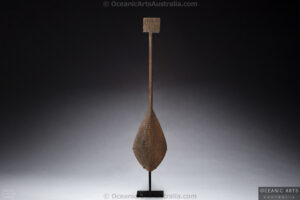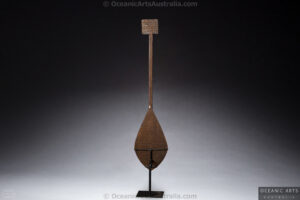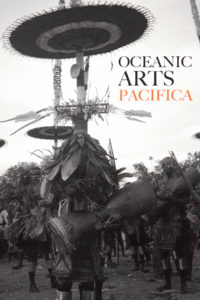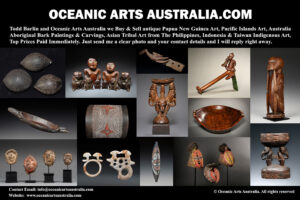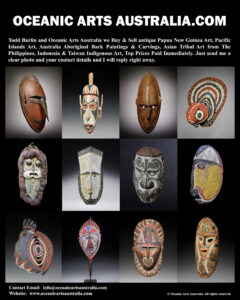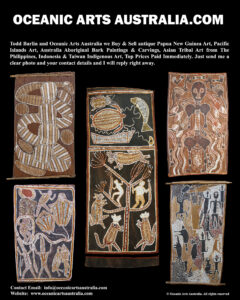A Superb Old Dance Paddle Austral Islands French Polynesia 19th Century
| Collection No. | SOLD |
|---|---|
| Size | Height 87cm x 19cm |
A Superb Old Dance Paddle from the Austral Islands in French Polynesia 19th Century, the Austral Islands are the southernmost group of islands in French Polynesia.
Carved from a single piece of medium-density wood the tiny chip-carved designs cover the entire surface on both sides of the paddle and the finial is carved in a rectangular shape that has three dancing figures linked hands to knees in a row on both sides of the paddle finial.
This Dance Paddle is in good condition for its age which is rare, it is dating from the 1870-1880 period when these were made for trade with visiting European ships that occasionally stopped by the islands for fresh water. In the pre-European contact era, there were likely similar Dance Paddles made and used for traditional ceremonies and as objects of prestige.
According to the expert on these paddles: Rhys Richards in The Tribal Arts Magazine (2012, pp 141 – 145),
“Though widely called ‘paddles,’ these objects are not functional paddles. They are ‘paddle shaped,’ but their sizes are too extreme; their shafts are too weak, and they are thoroughly unsuitable for use as paddles. Consequently, it has been assumed that they were emblems of rank or status, for ceremonial rather than functional use. But an exhaustive survey of the historical sources has confirmed that there are no known eyewitness accounts of their use or function. No local name is recorded for them, anywhere, before 1890, though they are sometimes called ‘hoe‘ after the Tahitian word for a paddle. Most Austral Island paddles are dated roughly between 1820 – 1840, mostly made probably on the Island of Raivavae, and are generally described as made for trade items, with their original use being treated as something of a mystery. There are good grounds for asserting however that few if any ‘paddles’ were made and exported after 1842. Firstly, the population decline was extreme, particularly among the adults, and dead men made no paddles. By 1840 the total population on Tabuai had fallen to 250 and on Raivave to 360…Actual carvers would have been even fewer. Moreover, after the French took over Tahiti in 1842, trade visits to the Austral Islands declined.”
Provenance: The Todd Barlin Collection of Polynesian and Oceanic Art
I first went to Papua New Guinea in 1985 for an adventure & what I found was that I really enjoyed being with the people of New Guinea, over the next 38 years I spent extensive time spent collecting and documenting traditional art & ceremonies in remote areas of Papua New Guinea & West Papua, The Solomon Islands & Vanuatu & the other Pacific Islands countries. During these travels, I made major collections of New Guinea & Oceanic Art for major Museums and Public Art Galleries
I was honoured by being in the prestigious Louvre Museum Magazine for the collections I made for The Museum of African & Oceanic Art Paris in1996 (now the Musee Quai Branly) for the exhibition “Asmat et Mimika d’ Irian Jaya April 1996 At THE MUSEE NATIONAL des ARTS D’AFRIQUE et d’ OCEANIE, Paris
See all of the links & photos in my new EXHIBITIONS GALLERY and there is the link to the article in the prestigious Louvre Magazine 1996
I have artwork for Museums & Art Galleries but also for collectors at every stage of their collecting. I want to encourage people to explore the fine art of New Guinea & West Papua and the Pacific Islands and to be able to see and touch the artworks in a relaxed and friendly manner in my Sydney Gallery. I would like to invite you to visit my gallery and see the artworks in person and also look at my website www.oceanicartsaustralia.com where there are many Galleries & Sub Galleries to explore.
My Gallery of nearly 40 years is the last physical gallery in Sydney that specialises in New Guinea & Oceanic Art. Sydney is just a couple hours’ flight to New Guinea & the Pacific Islands where all of these amazing artworks came from, Australia’s closest neighbours.
INQUIRE HERE
To see many more rare items and the finest masterpieces, please make an appointment with us to visit the gallery.
For all inquiries, please contact us.

